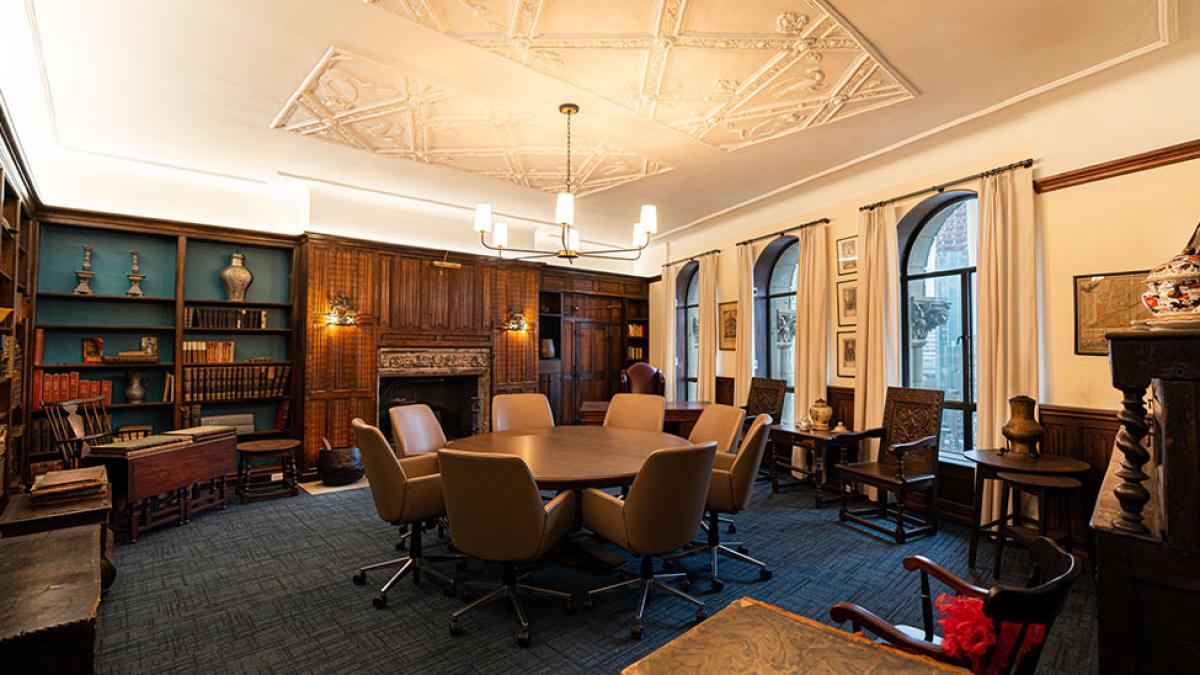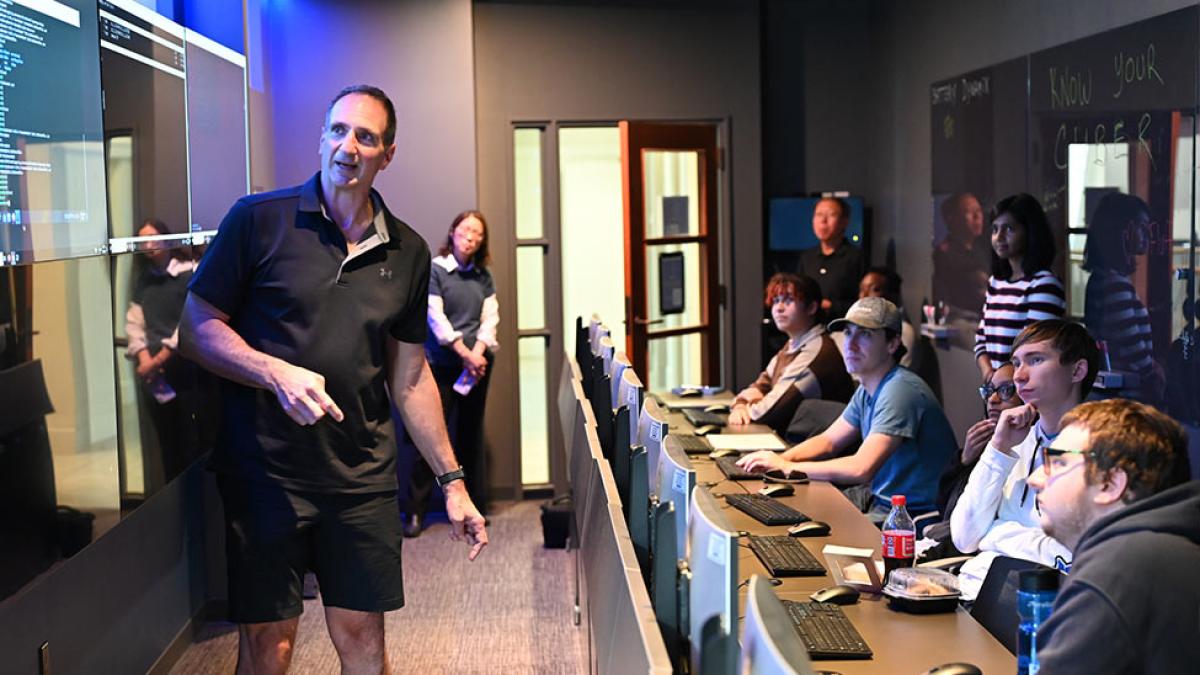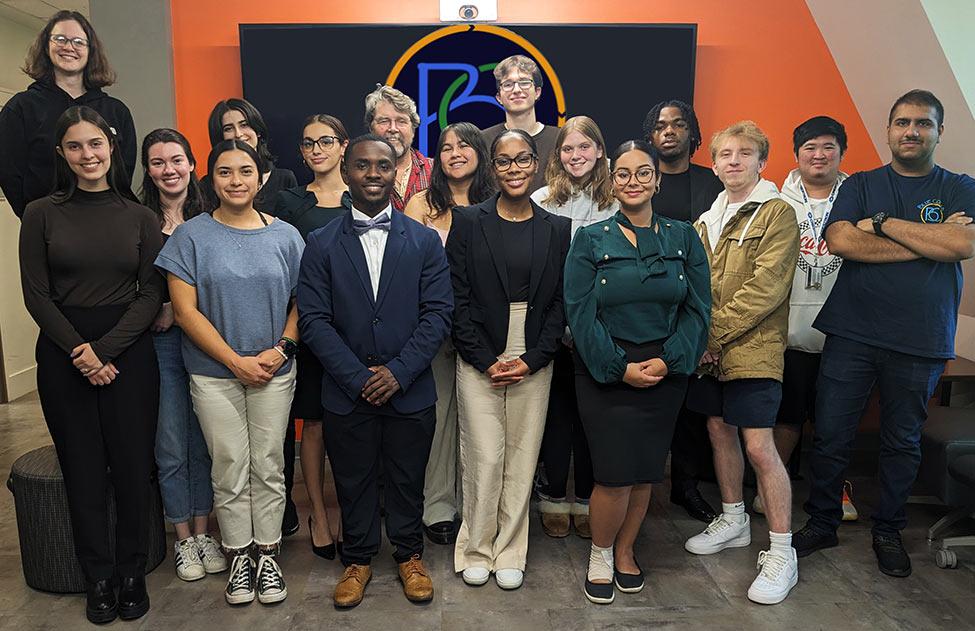
Learning Beyond Limits
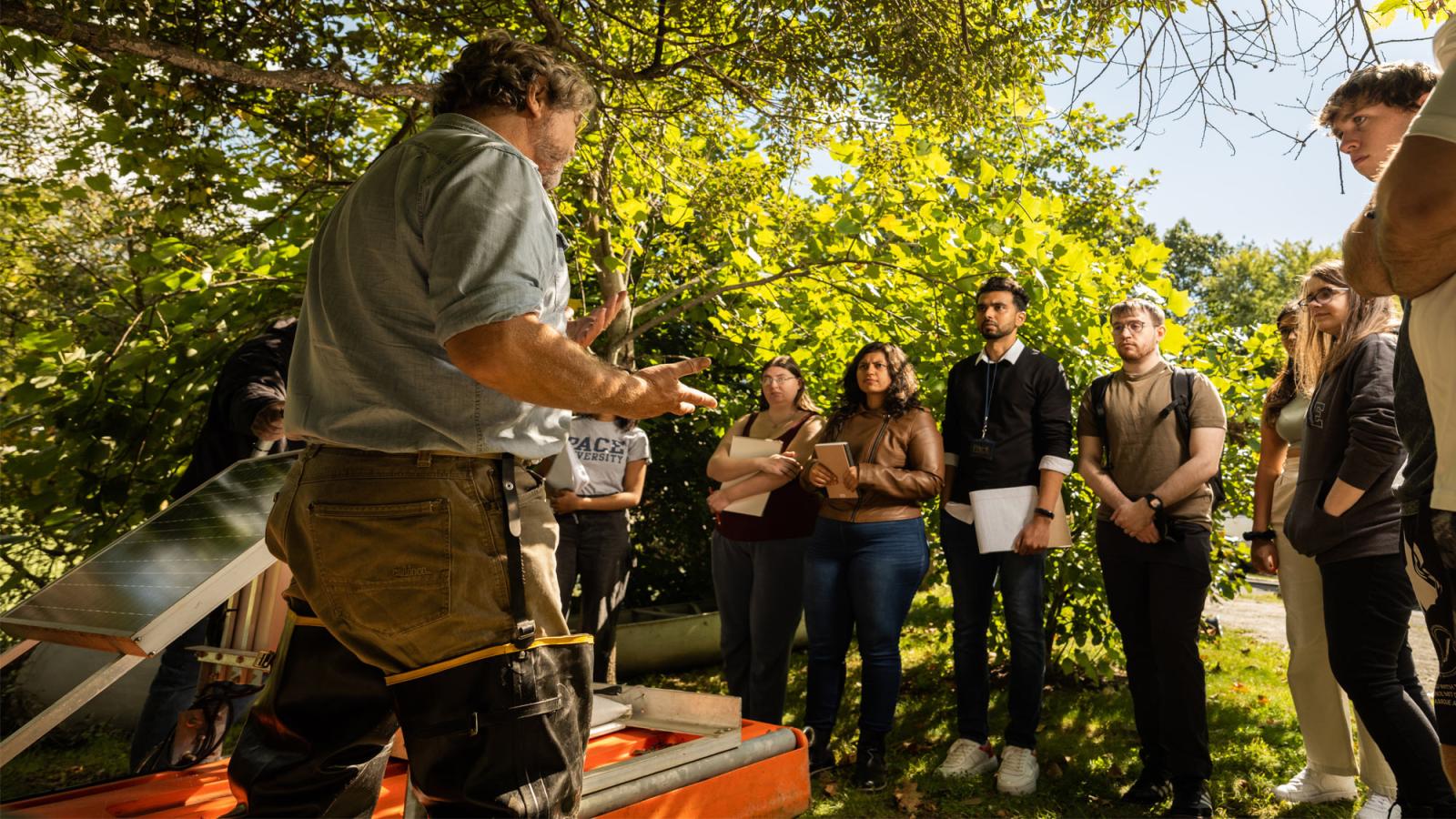
In recent years, there’s been a significant increase of focus on experiential learning in higher education, and for good reason. When it’s done well, experiential learning goes beyond preparing students for internships and full-time jobs. Students who have the opportunity to do their own research, make creative decisions, and take control of their learning are more likely to feel confident in shaping the world that they wish to see and live in. At Pace University, students across the University have opportunities to engage in experiential learning from their first year through graduation. This is the Pace difference—where learning is not a spectator sport but an exhilarating adventure that shapes resilient, adept leaders.
Director of Experiential Learning and the Pace Path Kelley Kreitz, PhD, supports and builds experiential learning opportunities—a key priority for Pace—within the University. “Pace has experiential learning opportunities running throughout our schools and liberal arts core curriculum,” Kreitz says, “Which allows students to participate in classroom-based research and civic engagement projects from their first day."
These opportunities help students build up their resumes before graduation, as well as support a widening of interests, exposure to new ideas, professional paths, and prospects that shape college experiences and ultimately lead to a fulfilling career.
Experiential Learning Across the Colleges
The strategic plan for experiential learning at Pace explains that “experiential learning is at the core of what we do. It encompasses learning both in and outside of our classrooms and involves students in original research, community engagement, internships, clinical placements, practical learning, problem solving, and building their professional skills.” Each college and school within the University offers unique chances for students to engage in their field of study, whether in class or in the community.
At the Seidenberg School of Computer Science and Information Systems, students can join the Blue CoLab team of interns, faculty, and staff to develop systems that protect humans and environmental health from water contamination. Within the Dyson College of Arts and Sciences, students can enroll in a course that provides them with the background and skills to collect oral history interviews covering COVID-19 and Black Lives Matter. Within the newly formed Sands College for Performing Arts, commercial dance majors travel to Los Angeles for a semester to practice directing, producing, acting, and dancing in their own shows. At the Lubin School of Business, students can gain hands-on managerial experience working with one of the five student-run businesses through the Center for Student Enterprise.
At Pace, “experiential learning” isn’t just the phrase du jour—it’s who we are. It’s who we’ve always been.
Blue CoLab: Right to Know What’s in Our Water
“We don’t know what’s in that glass before we drink,” Professor John Cronin, director of Seidenberg School’s Blue CoLab says. “I have a right to know what’s in my water.” And he would know. Cronin is known internationally for his 17 years as Hudson Riverkeeper and was named a Time magazine Hero for the Planet for his work fighting river pollution. At Pace, Cronin has been pioneering experiential learning for more than 20 years. He’s no stranger to inspiring student advocacy, as co-instructor for the Environmental Policy and Animal Advocacy clinics, coordinator of the annual Mock Legislative Hearing Competition, and even having co-founded Haub Law’s Environmental Litigation Clinic.
That’s the foundation of Blue CoLab, a project providing hands-on experiences in technological monitoring of water quality. With a strong commitment to the principle that there’s a human right to clean water, which requires the right-to-know that the water is clean, the program involves training, innovation, and research in real-time water monitoring technology.

More than two billion people will be threatened by unsafe water this year, which can lead to waterborne illnesses and other negative health outcomes. While many Americans see unclean water as an issue only in underdeveloped countries, the impact is local as well. This is demonstrated by the long-lasting impact to Parkersburg, West Virginia, caused by chemical dumping by Dupont and the lead contamination of drinking water in Flint, Michigan. In addition, 19.5 million illnesses are caused by pathogens in water in the US annually.
Cronin, Professor Leanne Keeley (who is Blue CoLab’s technical operations director), and a team of dedicated students work on the Pleasantville Campus tracking the health of Choate Pond, which eventually drains to the Hudson River. Meryl Mizell ’25, computer science major and Right-to-Know H20 team coordinator, explains the process, “In our pond, we have water quality sensors that monitor the water quality. We’re able to use that tech to pull data from the pond to allow people to see what the pond water quality is in real-time.”
The solar-powered water quality monitoring stations, lovingly named Ada and Alan (after 19th century mathematician Ada Lovelace, and British computer scientist Alan Turing, who broke the Nazi Enigma code) take measurements every fifteen minutes and send that data to a Seidenberg server. The team then uses that data to evaluate the water quality, create apps, products, and presentations that help deepen the public understanding of water. The pond serves as Blue CoLab’s “living laboratory,” complementing its data lab in Goldstein Academic Center and its tech lab off-campus.
“So overall, we do focus on the campus using the pond, but we want to implement it on a global scale,” says journalism major Lilah McCormack ’25. “The forefront of our idea is having the right to know what’s in the water we drink in real time. We do get water quality updates from local government agencies, but they only come after a year after you’ve used that water, so they’re not very useful in making healthy decisions.”
We have a really unique opportunity here at Pace, and I think that comes from our mentorship. What we’re doing here is really special.
Students work closely with Professor Cronin, who has been working on environmental issues for over 50 years. Lilah attributes the success of the Blue CoLab program and experience she is gaining to the mentorship and knowledge shared by Professor Cronin. “We have a really unique opportunity here at Pace, and I think that comes from our mentorship. What we’re doing here is really special. Sure, there’s a lot of initiatives towards ending the global water crisis, but nobody’s thinking about the technological advances that can make it possible.”
Recently, the six students who work on Blue CoLab’s Right-to-Know H20 project were accepted into the 2023 class of the United Nations Academic Impact and Millennium Campus Network Fellowship Program. The semester-long program gives students the opportunity to lead projects that advance the UN’s Sustainable Development Goals. The students working as part of the Right-to-Know H20 team are not merely advocates in civic engagement, but an active force striving to fulfill the United Nations’ Sustainable Development Goal, recognizing water as fundamental to all aspects of life. To aid the mission, the Right-to-Know H2O Team has petitioned the United Nations Secretary General António Guterres requesting the UN to declare the right-to-know water quality a fundamental human right.
The ability for these students from across the University to engage with experiential learning that revolves around critical scientific work helps to shape their college experiences, what they hope to do in their careers, and the way the world interacts with water.
“The work that we're doing here at Pace University is just the beginning of what’s possible,” concludes Sasha Palmer ’25.
The Oral History of COVID-19 and Black Lives Matter
The COVID-19 pandemic and the Black Lives Matter movement during 2020 forever shaped communities around our nation. Capturing first-hand experiences of how these events impacted people is a critical part of providing primary sources for future researchers, and that’s what Assistant Provost and Clinical Associate Professor of History Maria Iacullo-Bird, PhD, set out to achieve with her Oral History Project.
“Interviews provide a way to center personal human experiences during major historical events,” Iacullo-Bird says, “which become even more important as times of crisis and momentous change recede into history. I am excited that Pace undergraduates have generated primary sources to provide first-hand knowledge about watershed historical events.”
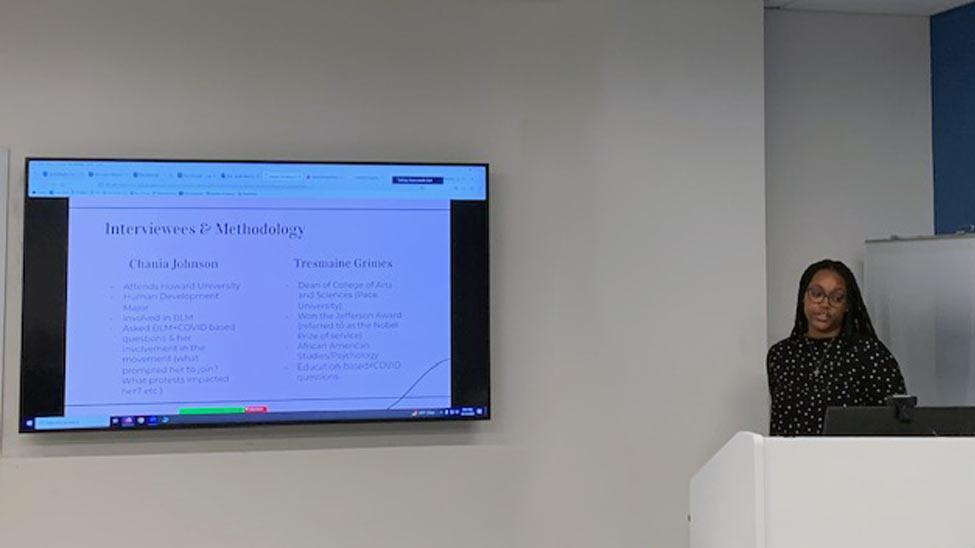
The project was developed as part of Iacullo-Bird’s Honors history course, HIS 196H: COVID-19 and Black Lives Matter: Comparative, Crisis-Based Oral History in the American Experience. The course is designed as a Course-Based Undergraduate Research Experience (CURE), which gives students training as oral historians to conduct research. Iacullo-Bird explains that this course in particular “explores the intersectionality between disease and social justice struggles.”
After students gain an understanding of the importance of oral history and develop close listening skills, students are tasked with selecting interview subjects and preparing questions that capture their interviewees’ unique experiences. Recent interviews are stored online on the Oral History webpage as a resource for other students and researchers.
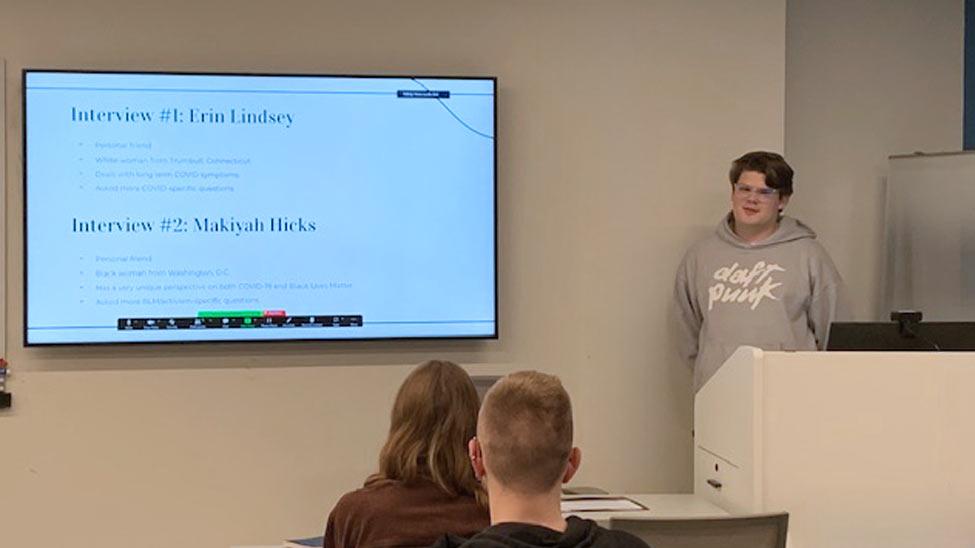
“The interviews I conducted were great experiences,” says film and screen studies major Carter Haskins ’24. He explored the intersectionality between race and the long-term health impacts caused by COVID. “I found that the conversation came naturally. I ended up going to interviews with a prepared list of questions but not using them, and the outcome was fantastic.”
I feel like I will be able to engage in more meaningful research now that I understand the importance of considering how a historical event affects those experiencing it.
Jillian Igneri ’26, added, “During the early stages of my interview preparation, I was excited by the prospect of exploring aspects of recent crises, namely the COVID pandemic and the matters of racial injustice throughout 2020, that I had not experienced through my own eyes as they occurred.” This led Jillian to explore how educators dealt with the disruptions to learning caused by the pandemic as well as how educators’ roles in helping students grapple with social change evolved.
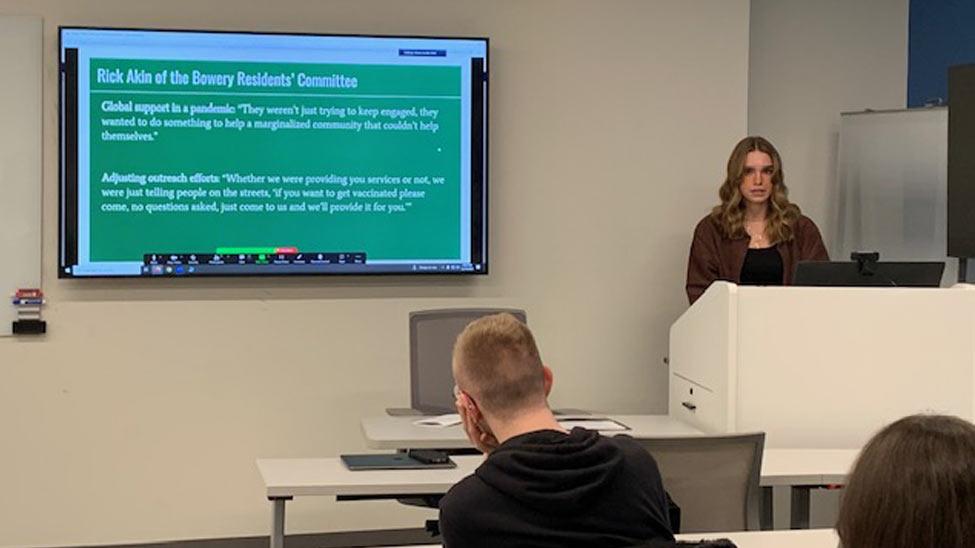
“Oral history has allowed me, as a history major, to engage with my community outside of the traditional academic space,” shared Natalie Filkins ’25, who focused her research on the impact COVID had on the unhoused population of New York City. “I feel like I will be able to engage in more meaningful research now that I understand the importance of considering how a historical event affects those experiencing it.” She adds, “As a historian, I found this project to be incredibly engaging, requiring me to exercise skills I haven’t used in other history courses.”
Na’Mya Sinclair ’26, a nursing student, who researched the Black Lives Matter movement and the function of higher education learning experiences for people of color, plans to continue studying nursing. However, she shares that “this project has significantly informed how I aspire to participate in the Pace University, New York City, and global communities. I am inspired to actively participate in discussions and initiatives that address racial inequalities, particularly within the university setting.”
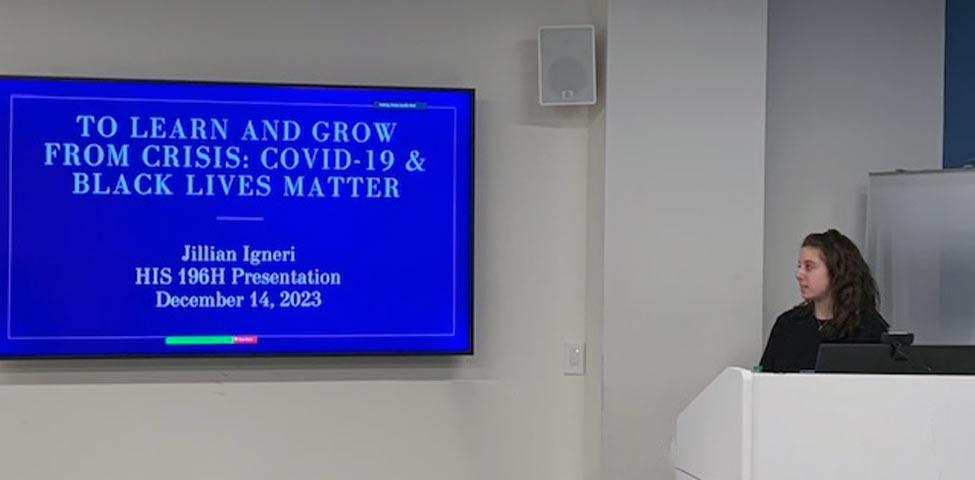
Iacullo-Bird hopes that students will “deepen their understanding of how to be engaged citizens and problem-solvers in community-building projects.” The skills they develop through the research-based course also enable students to clarify career goals and apply what they have learned both in their studies and the workplace.
A Semester in Los Angeles for Commercial Dance
“I remember telling the class of 2026, LA is the best semester. Just wait until you get to LA, you’re going to have the time of your life,” says commercial dance alumni Tiffani Russell ’23. She adds, “The previous statements were understatements.”
The goal of the commercial dance program is to prepare students to navigate the entertainment industry—across Broadway, concerts, TV, film, and working with music artists—as a dancer. Program head Rhonda Miller wants to set students up to be “completely prepared” to be comfortable with any style of dance, have the tools to book work, manage, and sustain longevity in their long-term careers.
Spending a semester in LA gives Pace students the chance to acquire and practice these skills. While dancers hone their skills in ballet and jazz in California, they’re also learning how to dance for the camera. “Dancing on camera is very different from dancing on stage,” explains Miller.
Tiffani says that the classes “advised us to think outside of our physical talents.” Students are challenged by industry professionals to learn about the variety of roles required to create movies, TV shows, concerts, Broadway performances, and music videos. The master teachers, who are active industry professionals, visit the students multiple times throughout the semester and provide information on the additional roles available in the industry beyond just dance.
Jillian Meyers, well known for working with Evolution Dance Company and Janet Jackson, is a regular instructor during the semester. Tiffani shares that Meyers taught about “the roles outside of dance that make up the industry, types of cameras, and how to choreograph for the camera. For a commercial dancer, exposure to these working professionals in an educational setting is unheard of.”
Students also have the opportunity to connect with agents, who act as a dancers’ representation and facilitate auditions. Working with bi-coastal agencies sets students up to find work in Los Angeles and New York City. Miller brings agencies to the students throughout the semester, giving agents time to watch the students dance in a private setting. As a follow up to that initial introduction, students prepare a showcase for the end of the semester, where dance agents, choreographers in the industry, and directors will be in attendance.
The stress of getting an agent is off the table. I feel very proud of that because a lot of people move to LA or New York, and they have to go to these huge calls to try to get an agent. Whereas I’m bringing the agencies directly to the students.
“Our showcase is exciting because some performances are done live in front of the agents, choreographers, and directors,” says Miller. “And then we also show a great deal of work done on film. Different projects that the dancers have done during the semester are shown so that agencies can see dancers in two different realms and decide someone is really great.”
Miller estimates that 70 to 75 percent of her students are agented by the end of their third year in the program, following the semester in LA. “The stress of getting an agent is off the table,” Miller says, adding, “I feel very proud of that because a lot of people move to LA or New York, and they have to go to these huge calls to try to get an agent. Whereas I’m bringing the agencies directly to the students.”
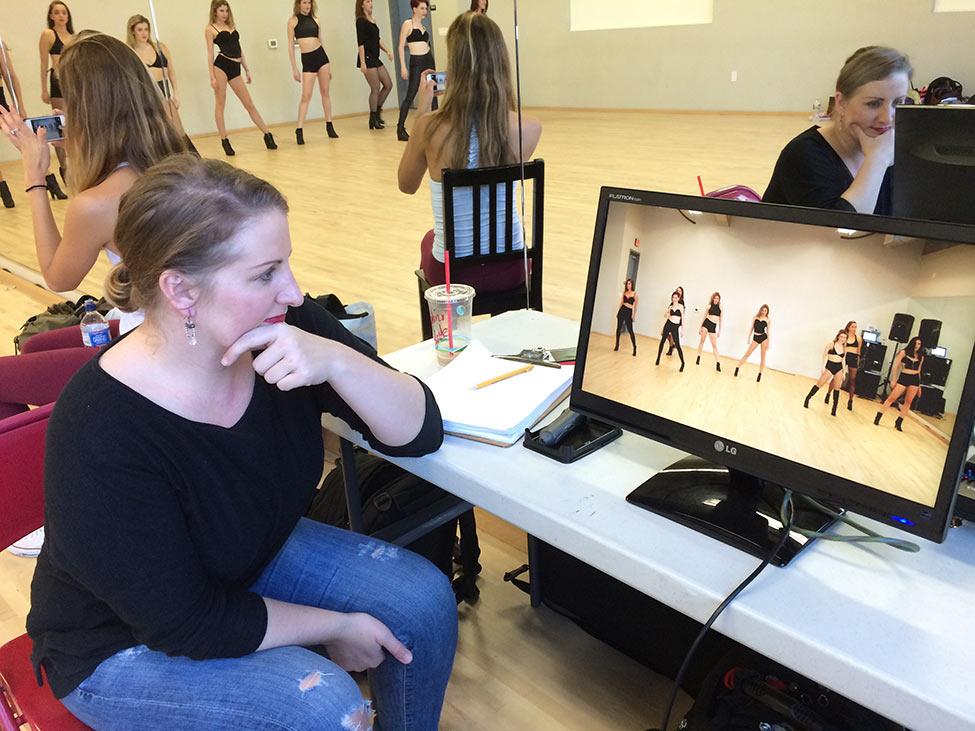
Students in the commercial dance program often work short gigs, like commercials, during their senior year, which is something the program is structured to accommodate. After graduation, students find success working with TV, film, and dancing with musical artists. “We had a lot of students that did the Video Music Awards last year in New York,” says Miller. “One alumna, Briana Pavon, is performing with Beyoncé now. At least two of our alumni received callbacks for tour auditions with Olivia Rodrigo, which just happened the week of January 8.”
Tiffani, who has gone on to work with Doja Cat at the 2023 VMAs, shared, “I have always dreamed of dancing behind an artist, seeing myself on my TV, or getting to perform live in front of an arena full of people. With the LA semester under my belt, those dreams were made possible.”
Managerial Experience with the Center for Student Enterprise
At the Center for Student Enterprise (CSE) within the Lubin School of Business, Pace students are busy at work. They’re not just doing homework; they’re employed at and managing five different student-run businesses on the Pleasantville Campus.
More than 70 students work at the businesses. Xavier Flores ‘25, Business Management BBA and Marketing Management MBA, is one of those who has loved his experiences with the companies.
“I first got involved with CSE in the fall of my first year,” he said. “I applied right after orientation and was hired at Pace Delivers as a driver. By the end of my first year, I was promoted to General Manager.” Pace Delivers, founded in 2017, provides food delivery to students from local restaurants.
Xavier continued, “Going into the Spring 2024 semester I will be the General Manager of Pace Perk. When I first started, I had so many questions about how the business operated, and over the past three years, I have been able to answer all the questions I had.”
Working as the General Manager of Pace Delivers gave Xavier an opportunity to learn skills he might not have otherwise picked up from his classes. He says that attending board meetings improved his public speaking skills, helping the marketing manager gave him experience with Canva, Excel, and Instagram, and collaborating with the CFO gave him experience with QuickBooks. “I have learned and gained as much as I could through my time spent at CSE, but I will use all of these skills. I think it will give me a leg up going into my career because being part of and managing a student-run business is something that very few college students get the opportunity to do,” he said.
“My experience working for Pace Mart has been truly a blessing,” says Pace Mart Senior Marketing Manager and Lubin BBA student Joseph Ingles ’25. “My hard skills and soft skills have enhanced greatly. Running a business like Pace Mart, sometimes things come up out of nowhere and you just have to adapt to the situation at hand. That experience has made me stronger and prepared for what is to come.”
Maggie Glynn is another student who can testify to how working at a student-run business has impacted her experience at Pace. Maggie ‘26, Public Accounting BBA and MBA, is the Chief Financial Officer of Pace Fit, the healthy snack bar located in Goldstein Fitness Center. “I have gained so much real-world experience from the CSE,” Maggie says. “I was drawn to Pace for the internship opportunities, but little did I know I would gain a deeper understanding of the workforce and what I want my role to be from working on campus. Working at Pace Fit allowed me to get real-world accounting experience as a sophomore. I learned what I love about the profession and where I can see myself continuing after graduating.”
She adds that she has gained invaluable technical and soft skills between managing a team, problem solving, and handling finances, “I learned how to prepare, analyze, and present financial statements for board meetings. I learned the value of communication, compromise, and leadership.” Maggie insists, “This continues to be a skill that sets me apart from other candidates when interviewing for accounting internships.”
All of the student managers tell me that when they go for interviews for internships or full-time jobs that all the interviewer wants to ask them about is their position at the student-run business.
Kathryn Winsted, PhD, is the director of the Center for Student Enterprise. She has a deep understanding of how experiential learning enhances what students do in the classroom and helps them discover what really matters in the world of business. Winsted has acted as the advisor to all five of the student-run businesses since they first opened in 2010, and has helped students succeed through different challenges, including COVID-19. Throughout the years, she has seen students thrive in their roles and launch into careers they feel passionate about.
“All of the student managers tell me that when they go for interviews for internships or full-time jobs that all the interviewer wants to ask them about is their position at the student-run business,” Winsted said. “My favorite story is when the student who was one of the original founders of Pace Mart went for an interview at J.P. Morgan, she was able to answer the situational questions with real experiences she had at the business she was running. She was hired on the spot.”
Beyond seeing students find success in their careers, Winsted knows that the students “learn so much more in their courses when they use it in running the businesses and bring that practical experience to their learning.” She hopes that they learn beyond classroom concepts as well, saying that there are many opportunities to practice handling conflict and problem solving, aiding them in becoming adaptable and finding self-motivation.
Both Xavier and Maggie said that they would recommend interested students to get involved. “If any Lubin students are hesitant about joining a student-run business, do it!” Maggie shared.
The Future of Experiential Learning at Pace
For Pace University, experiential learning isn’t just a flash in the pan and it’s certainly not a response to trending topics in higher-ed forums. The plans for hands-on learning will continue to include working on building even more first-year experiences, providing opportunities for students from across majors to work together, and eventually collaborative spaces to work on projects.
My overarching goal is to achieve a sense of identity, community, and pride in our approach. I want to realize our potential to be a nationally recognized model of an experiential future of higher education.
Kelley Kreitz knows that the University will continue to adapt. “Classrooms at all kinds of educational institutions have historically provided a one-way flow of information from the professor-as-expert to the student-as-learner,” she says, adding, “My overarching goal is to achieve a sense of identity, community, and pride in our approach. I want to realize our potential to be a nationally recognized model of an experiential future of higher education.”
More from Pace Magazine
Nestled in a corner of the 16th floor of the iconic 41 Park Row, a building steeped in history, the Pace Study is a hidden gem. Within its walls, the Study served as the workspace for Robert S. Pace, the second president of Pace University and son of co-founder Homer Pace. Nowadays, it's a haven for small, but significant University meetings.
When his wife Kimmi Stephens suddenly had a seizure, Tim Myers, a scientist studying epilepsy, felt his field of study abruptly collide with reality. This shocking moment sent the pair of Pace professors on a winding journey of recovery, resilience, and research, and ultimately to the creation of a new lab on the Pleasantville Campus.
Meet Cyber Range: Pace’s new, state-of-the-art facility designed to give students a collaborative, practical immersion in tackling real-life cybersecurity threats, all in real-time.
